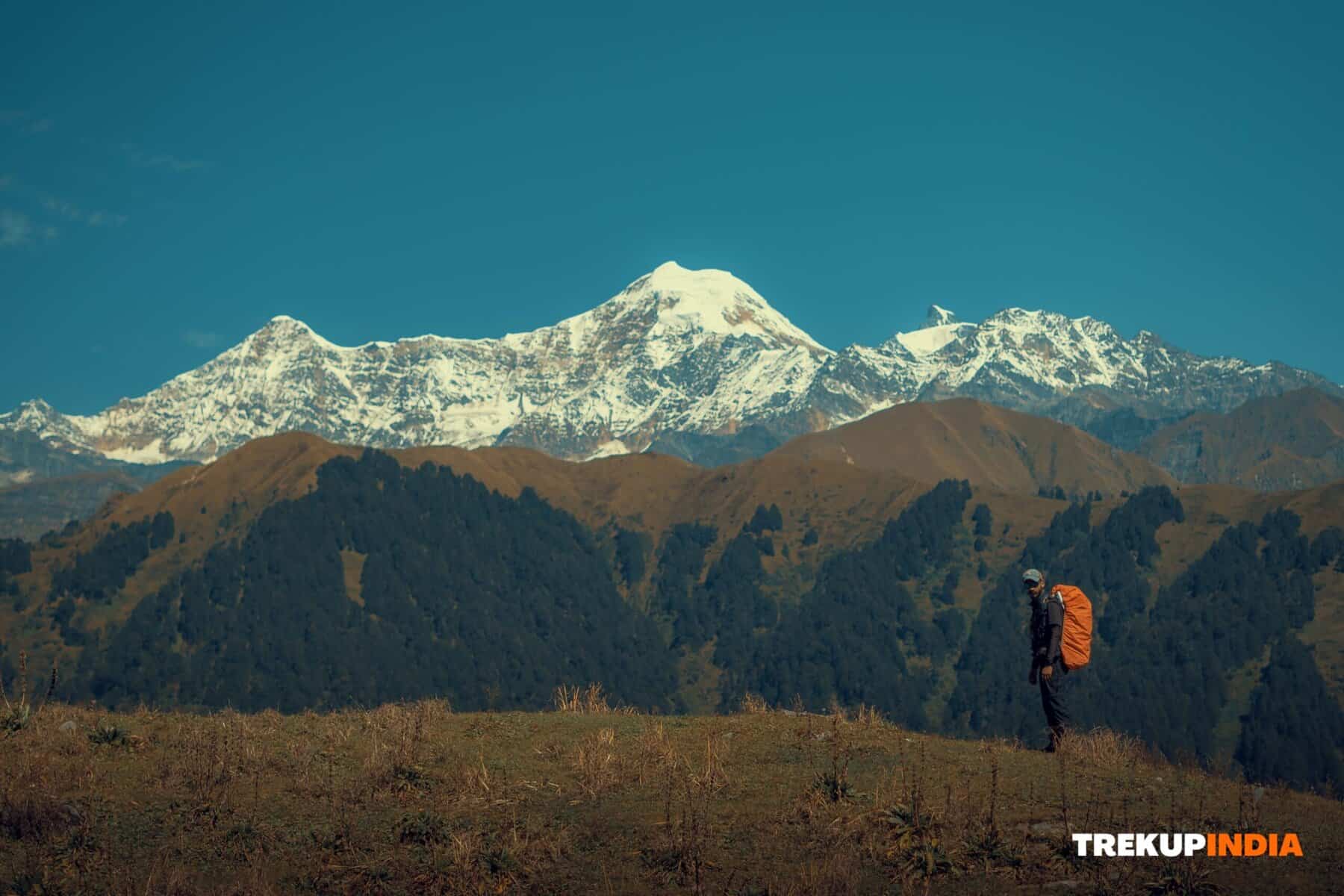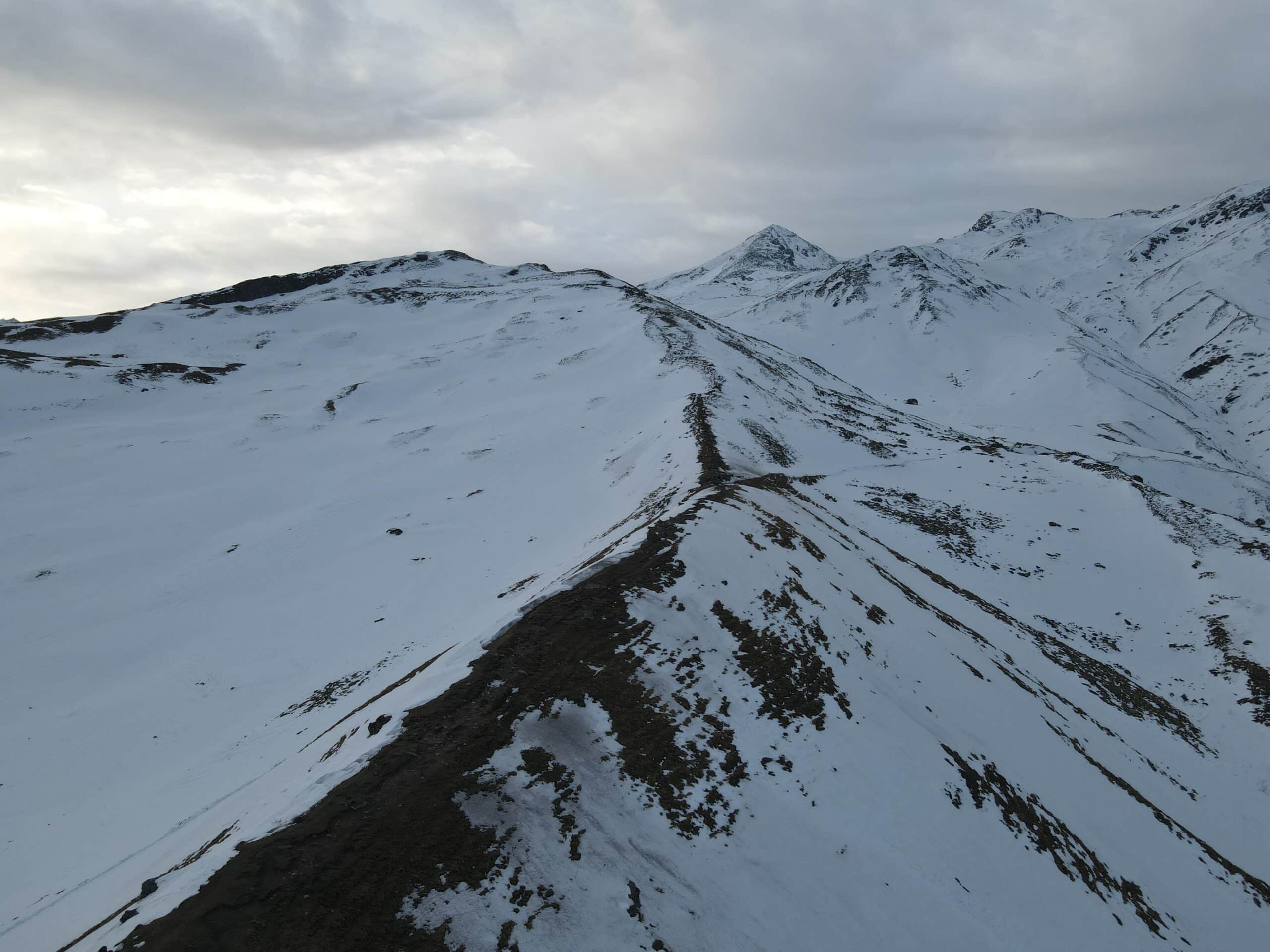Why You Should Do Buran Ghati Trek
Buran Ghati Trek offers a complete package of mountains, grasslands, and forests. Buran is an ancient charming village with old houses and fruit-bearing trees. The trek offers breathtaking views of snow-capped peaks, lush meadows, dense forests, and gushing streams. The region’s natural beauty is awe-inspiring and immerses you in the serene and pristine surroundings.
- Forest – Take an excursion through the dense forest of Oak and Pine; we will climb deep into the coniferous forest. The forest of Bhoj (silver birch) is a stunning setting, and you can see Litham from here. You will reach a large stream that joins the Barua Khud, and after about an hour of descent, you’ll see many more shrubs as you cross the stream. You might also spot peaches, pears, apricots, and apple trees along the way.
- Meadows – Vast green grasslands spread across the mountains; you would be walking past Dayara Meadows. Dayara Thatch’s meadows become more artistic when the sun first shines.
- Snow-covered Peaks – Peaks are crowned with a white blanket at the top, a sight to behold. You will be awestruck by the Dhauladhar range and get a panoramic view of the Kinner-Kailash peaks.
- Chandranahan Lake – It is a high-altitude lake which is located in a narrow valley and snowy section. This glacial lake remains frozen almost all year round.
- Buran Ghati Wall – It is an incredible thrill to rappel down from the other side of Buran Ghati and reach the top of Buran Ghati. Buran Ghati wall is now well-known. It must be the highest point of rappelling in the world! Buran Ghati is a beautiful adventure because you can slide down several snow chutes.
- Janglik – This walk will take you past beautiful step fields of wheat and hand-crafted wooden farmhouses. These charming wooden and stone houses with beautiful green and red roofs will grab your attention.
- Burwa – Burwa is an ancient charming village embellished with old houses and fruit-bearing trees.
- Shepherd Trail – The climb to Dhuna will start by following the shepherd trail to the pass, and you can see the Buran Ghati trail from there.
- Flora and fauna – The trek offers a chance to witness a variety of flora and fauna native to the region. You might encounter species like the Himalayan Monal, pheasants, ibex, and other Himalayan wildlife.
for booking and more information
Share this article
Want To Trek Like Pro?
Check out the following videos if you want to trek like a pro trekker and improve your skills. These videos contain helpful tips, tricks, and techniques to help you trek like a pro. Whether you’re a beginner or an experienced trekker, these videos can provide valuable insights to enhance your trekking experience. So, watch the videos below by Trekup India experts to take your trekking skills to the next level.







Know Everything About Acute Mountain Sickness
Acute Mountain Sickness is a medical condition that can occur when individuals travel to high altitudes, typically above 8,000 feet. It is caused by the decrease in air pressure and oxygen levels in the air as altitude increases. Symptoms of Acute Mountain Sickness may include headache, nausea, vomiting, dizziness, and difficulty sleeping. To avoid Acute Mountain Sickness, it is important to gradually adjust to high altitudes and seek medical attention if symptoms worsen. To learn more about this condition, check out the videos by Trekup India.



Important Guidelines
Special Casual Leave (SCL) for Government Employees
Government employees joining our trekking expeditions can avail of Special Casual Leave (SCL) under the following conditions:
- Eligibility Criteria:
- SCL is available exclusively to Indian government employees.
- Applicable only for treks conducted within India.
- Leave Details:
- As per Pay Commission rules, government employees are entitled to up to 30 days of SCL in a calendar year for trekking or mountaineering expeditions.
- Treks must be organized by a registered organization, such as Trekup India, recognized by the Indian Mountaineering Foundation (IMF).
- Application Process:
- You need to apply for leave at least 20 days before the trek departure date.
- How to Apply: The following details are required to apply for IMF certification through the IMF.
- Email info@trekupindia.com with the following details:
- Your booked trek date.
- The trek name.
- Aadhar Card
- Designation
- Office Address
- Additional Fee of Rs. 250/ per person will be applicable.
- Note: It might take 20-25 days to receive a certificate from the IMF, subject to their approval.
- Email info@trekupindia.com with the following details:
- Documentation Support:
- Trekup India will provide the necessary documents to facilitate your SCL application.
Age-Based Requirements for Junior Trekkers
- A parent or guardian must accompany trekkers below 15 years of age.
- Trekkers Aged 15 to 18 or above Years: Can trek solo but require a Disclaimer Form signed by a parent or guardian. And Medical Form that Provides health details and confirms fitness for trekking by MBBS Doctor
- Trekkers Aged above 18 Years: Require a Disclaimer Form self-signed. And Medical Form that Provides health details and confirms fitness for trekking, Signed with an MBBS Doctor stamp.
Medical Fitness Required for Trek
If you’re planning a trek, you must ensure that your health parameters meet the fitness requirements for physical exertion at high altitudes or rugged terrains. Below are guidelines for each of the parameters mentioned:
1. Pulse Rate (Heart Rate at Rest):
- Normal: 60 to 100 (bpm) beats per minute.
- Required Fitness: Physically fit person may have a resting heart rate closer to 50 bpm, which shows that he have good cardiovascular efficiency.
2. Blood Pressure (BP):
- Required BP: 120/80 mmHg. A Bolood Pressure within this Range ensures adequate oxygen delivery to muscles and organs during physical exertion, especially at high altitudes.
- Your specified blood pressure (BP) Range—Systolic: 100–140 mmHg and Diastolic: 70–90 mmHg—is appropriate and generally considered safe for trekking activities.
- Acceptable Range: <140/90 mmHg for trekking. Elevated BP could increase risks during strenuous activity or at high altitudes.
Recommendations:
- Pre-Trek Checkup: Monitor your BP multiple times & ensure that it should be normal.
- Stay Hydrated: Dehydration affect BP, so maintain proper fluid intake during your trek.
- Avoid Alcohol & Excess Salt: These can destabilize BP, especially at altitude.
- BP Monitor: If you have a history of BP issues, regularly check your BP during the trek. Our Trek Leaders are equipped with a BP machine.
3. Respiratory Rate at Rest:
- Required Rate: 12–20 breaths per minute.
4. Diabetes Mellitus:
- Acceptable: Well-controlled blood sugar levels (HbA1c <7% or fasting blood glucose <126 mg/dL).
- Fitness Requirement: Carry quick glucose sources and monitor regularly during the trek.
5. Bronchial Asthma:
- Acceptable: Only when your doctors allow it & you have to submit an MBBS doctor NOC that you can undergo this trek.
- Fitness Requirement: Bring prescribed inhalers/medications and consult your doctor about high-altitude risks.
6. Heart Problems:
- Acceptable: Individuals without recent cardiac events (e.g., heart attack within the past 2 years).
- Fitness Requirement: Clearance from an MBBS Doctor (cardiologist) is required.
7. Hypertension:
- Acceptable: Controlled hypertension (BP <140/90 mmHg) with no recent complications like hypertensive crisis.
8. Pacemaker Implant:
- Generally not recommended for high-altitude treks.
9. Body Mass Index (BMI):
- Required BMI: 18 – 26 kg/m² for a good trekking fitness.
- Overweight or underweight individuals may face additional strain on joints or fatigue.
Additional Recommendations:
- High Altitude Acclimatization: For treks above 10,000 feet, ensure have some acclimatization Trekup India have designed Itinary of this trek accordingly to it but its not granted that this itinary works fine with acclimatization. For more information, click here.
- Fitness Level: Regular aerobic and strength training exercises before the trek are essential. For more information, click here.
- Medical Clearance: Consult a healthcare professional (MBBS Doctor) to assess your suitability before coming on this trek.
Would you like assistance preparing for your trek or calculating specific health metrics? Call Your Trek Co-Ordinator






